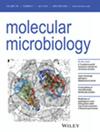Genome-Wide Analysis of DtxR and HrrA Regulons Reveals Novel Targets and a High Level of Interconnectivity Between Iron and Heme Regulatory Networks in Corynebacterium glutamicum
IF 2.6
2区 生物学
Q3 BIOCHEMISTRY & MOLECULAR BIOLOGY
引用次数: 0
Abstract
Iron is vital for most organisms, serving as a cofactor in enzymes, regulatory proteins, and respiratory cytochromes. In Corynebacterium glutamicum, iron and heme homeostasis are tightly interconnected and controlled by the global regulators DtxR and HrrA. While DtxR senses intracellular Fe2+, HrrSA is activated by heme. This study provides the first genome-wide analysis of DtxR and HrrA binding dynamics under varying iron and heme conditions using chromatin affinity purification and sequencing (ChAP-Seq). We revealed 25 novel DtxR targets and 210 previously unrecognized HrrA targets. Among these, metH, encoding homocysteine methyltransferase, and xerC, encoding a tyrosine recombinase, were bound by DtxR exclusively under heme conditions, underscoring condition-dependent variation. Activation of metH by DtxR links iron metabolism to methionine synthesis, potentially relevant for the mitigation of oxidative stress. Beyond novel targets, 16 shared targets between DtxR and HrrA, some with overlapping operator sequences, highlight their interconnected regulons. Strikingly, we demonstrate the significance of weak ChAP-Seq peaks that are often disregarded in global approaches, but feature an impact of the regulator on differential gene expression. These findings emphasize the importance of genome-wide profiling under different conditions to uncover novel targets and shed light on the complexity and dynamic nature of bacterial regulatory networks.

谷氨酸棒状杆菌DtxR和HrrA调控子的全基因组分析揭示了铁和血红素调控网络之间的新靶点和高水平互联性
铁对大多数生物体都是至关重要的,它是酶、调节蛋白和呼吸细胞色素的辅助因子。在谷氨酸棒状杆菌中,铁和血红素的稳态是紧密相连的,并由全球调节因子DtxR和HrrA控制。当DtxR感知细胞内Fe2+时,HrrSA被血红素激活。本研究首次利用染色质亲和纯化和测序技术(chapq - seq)分析了DtxR和HrrA在不同铁和血红素条件下的结合动力学。我们发现了25个新的DtxR靶点和210个以前未被识别的HrrA靶点。其中,编码同型半胱氨酸甲基转移酶的metH和编码酪氨酸重组酶的xerC在血红素条件下仅与DtxR结合,强调条件依赖性变异。DtxR激活甲基甲氧基将铁代谢与蛋氨酸合成联系起来,可能与减轻氧化应激有关。除了新的靶标,DtxR和HrrA之间共有16个靶标,其中一些具有重叠的操作符序列,突出了它们相互关联的规则。引人注目的是,我们证明了在全局方法中经常被忽视的弱cap - seq峰的重要性,但其特征是调节因子对差异基因表达的影响。这些发现强调了在不同条件下进行全基因组分析对于发现新的靶点和揭示细菌调控网络的复杂性和动态性的重要性。
本文章由计算机程序翻译,如有差异,请以英文原文为准。
求助全文
约1分钟内获得全文
求助全文
来源期刊

Molecular Microbiology
生物-生化与分子生物学
CiteScore
7.20
自引率
5.60%
发文量
132
审稿时长
1.7 months
期刊介绍:
Molecular Microbiology, the leading primary journal in the microbial sciences, publishes molecular studies of Bacteria, Archaea, eukaryotic microorganisms, and their viruses.
Research papers should lead to a deeper understanding of the molecular principles underlying basic physiological processes or mechanisms. Appropriate topics include gene expression and regulation, pathogenicity and virulence, physiology and metabolism, synthesis of macromolecules (proteins, nucleic acids, lipids, polysaccharides, etc), cell biology and subcellular organization, membrane biogenesis and function, traffic and transport, cell-cell communication and signalling pathways, evolution and gene transfer. Articles focused on host responses (cellular or immunological) to pathogens or on microbial ecology should be directed to our sister journals Cellular Microbiology and Environmental Microbiology, respectively.
 求助内容:
求助内容: 应助结果提醒方式:
应助结果提醒方式:


